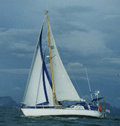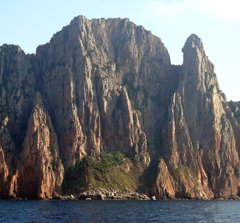Weatherly Sailing Adventures














Corsica is actually French and Sardenia is Italian. I only combine them here, because they are close by each other geographically, and I had only a short time in each island. Both have have individual characters and differ from their mainlands.
I arrived at Porto Vecchio, in the the south-east of Corsica, one morning after an overnight sail from Gianutri Is. It is a large, elongated, natural harbour, sheltered from the sea from all sides, and I found a nice anchorage at the very end just off a small beach. The walk to town was pleasant with the fresh smell of pine trees, which backed the beach. Behind the pines was a large brackish lake having its own smell of reeds and marshland. The lake came right up to the road at one place, with nice views out to small rocky islands. I felt to be on holidays here. The sun was shining and reflecting from puddles from recent rain, and I felt a sense of freedom to paddle my dinghy ashore and wander into town at leisure. The town was up on the hill, fortified and walled, with a heavy gateway that the road passes through. At night there were folk songs, in French, eminating from a lively tavern built into the wall at the gate entrance, and it was enticing to go in except for the 20euro cover charge.
Making my way south in strong wind, I had aimed to anchor in a small circular bay, Cala Rotonda, which looked to have pefect shelter. Arriving there, I found a lot of other motor boats and yachts crammed in, and the wind was gusty and strengthening. I couldn't get my anchor to hold in the hard packed sand with that force of wind, so got out of there (with a lot of difficulty alone hauling up the anchor). Heading further south, the wind developed more, up to force 9 (45 knots - or 90km/hr). The forecast was for only force 7, but this area gets reinforced wind from the mountains and funelling effect of the Bonifacio Strait. It was slow going against the chop, even close in, and it was with some relief to find that the next anchorage on my chart was a great refuge from the weather. I set 2 anchors at cala Balistra and tested that they weren't dragging. There was plenty of room to swing and the depths were fairly even for a few hundred metres behind the beach. So I set to making dinner and had a reasonable sleep while the wind raged outside.
The wind eased a bit the next day (to force 7) and I had a fast sail towards Sardenia under reefed sails. The seas were choppy in the strait of Bonafacio and it was another hard day sail. Cala Spalmatore, the anchorage I picked out from the guide book, looked to have a great aspect and there wasn't another anchorage anywhere near. So I was dismayed to find it full of pink mooring buoys and a rubber dinghy motored out to greet me. 'You must take a mooring buoy, no anchoring allowed. It's 40 euro per night' the man told me as I prepared my anchor. 'I can't afford that, and it's dangerous to anchor outside this cala'. So the conversation went on. He finally compromised down to 20euro and I took a mooring, a little reluctant to pay that sort of money, after my usual free anchoring style, but relieved that the moorings were secure and I would sleep soundly without worrying about dragging into the rocky shores. It was a common trend that the 10year old guide book was out of date and disappointing to find many of the picturesque anchorages had been converted to yacht harbours or buoyed moorings, and often crowded with boats. Lucky I'm making my trip now and not in another 10 years. The Mediterranean looks to be headed for only richer boat owners in the future, if all the possible anchorages are used up in this way.
The next morning the wind dropped right off, and I set out on a 5km walk to the main town on la Maddelina island to buy some groceries and make a phone call. The island is rocky and hilly with low shrubs and I thought how similar it looked to parts of Australia. Garibaldi, reknowned as the man who unified Italy, spent the last years of his life here in exile, and his house is maintained as a national monument.
I sailed on to Porto Cervo where the ultra rich and fabulous come to stay in huge motor yachts, and tasteful landscaped homes. Occasionally their helicopters would fly overhead. I took a pic of Weatherly in foreground appearing larger than the huge motor yacht toys berthed to the marina behind, though their masts were much higher than Weatherly's. The Rolex cup racing regatta was on when I was there and the marina was a flurry of muscular crew in neat uniforms, and sails flapping in the wind as fine tuning was made to the rigs. To see these sleek racing machines in action was exciting, and they made incredible speeds under spinnakers
I found a wonderfully remote, almost deserted bay at Liscia, with just a few yachts spaced well apart on anchors. In the morning I walked along the beach. During the day there were many windsurfers enjoying the strong wind, reaching back and forth dangerously close ahead and astern of my yacht, any miscalculation would result in a gory ending. The bay was quiet after the windsurfers packed up. It was very attractive with a long sandy beach ending in boulders near my anchorage, and offered good shelter with flat water.
Back to Corsica, I sailed past Bonafacio town, perched on the brink of white cliffs. The postcards show it to be a spectacular place to visit, but the wind and sea was too wild to stop in the marina inside the calanque (gorge) there.
However, the next anchorage was ideal, sandy bottom and surrounded by spectacular rocky cliffs. The next morning I met an elderly walking party from the Pyrenees mountains in the west of France. They sported ski poles and laughed when I asked 'Is there snow up there'? For all the equipment and maps they seemed a bit awkward. To the mirth of their group, one fell backwards into a dirt trench when I asked if they knew how to get to the fort. 'No, it's not possible, we tried all the paths from here'. I followed a lanky local man up who kindly offered to take all of us there, but the walking party went off in another direction, not believing him. The path was straight forward, and marked with white triangles, though quite steep, and we had a great view from the fort above. Then down the other side to a nudist beach, where the water was refreshing and very clear due to smooth, round pebbles, not sand.
My cousin, Mike, joined me in Ajaccio, mid way up the west coast of Corsica. He was able to get a couple of weeks vacation at short notice, and it fitted in well with my cruise in Corsica.
First we took a train into the rugged interior of Corsica, to do a pleasant forest walk and had a dip in a cold mountain stream at Cascades des Anglais.
Then we cruised up the rocky coastline, anchoring in some quiet bays. One of the nicer places was in Ficajola Bay where a group of kayakers were camped for the day. Granite rocks walled off the side of the beach, and kids were leaping off ledges, their hollering echoing from the cliffs.
The west coast was mainly unpopulated and very rugged, with red craggy rocks and isolated coves. We passed through a narrow channel between some red rocks, with a fort above, and had a swim. There were many yellow fish, a cod and seaweed amongst the underwater boulders, but not as impressive as we'd imagined in this marine park. The swim was good exercise anyway.
Sailing past the fortifications of Calvi was interesting. The ramparts start from the water and rocks and continue up in a multi-sided structure. We took a mooring, since anchorage was forbidden, and explored the citadel and tourist town below.
The next day we boarded a train which runs right along the beach front and passengers hail it to get on. It was very rickety and old which made it more fun to ride on. We stopped at the end, had a swim and looked around. Some locals were playing boules in an area in front of the church. The best part though, was stopping at a surf beach on the train ride back. I actually body-surfed some waves there, up to a metre high, which surprised me to see surf any in the Mediterranean.
After a few days, when the forecast was good we headed off across the Ligurian Sea for Monaco and France though there was little wind, and it ended up being a long motoring trip, hardly as challenging as I'd anticipated.











